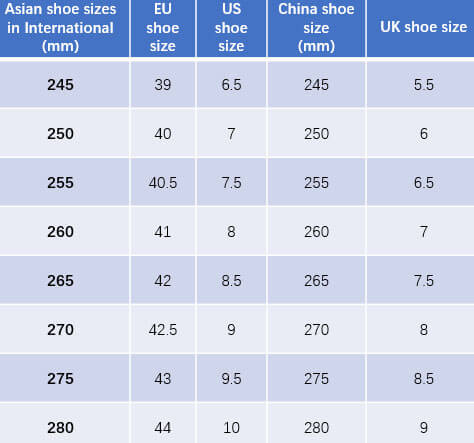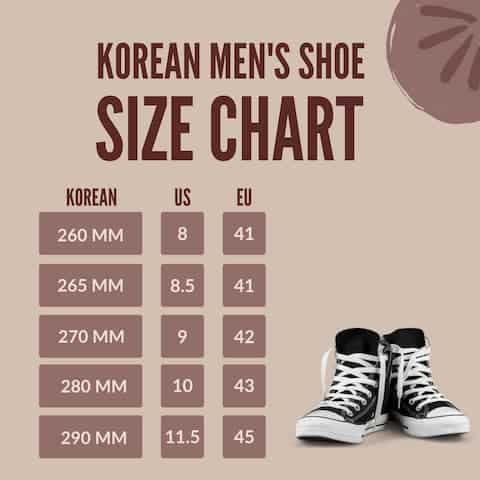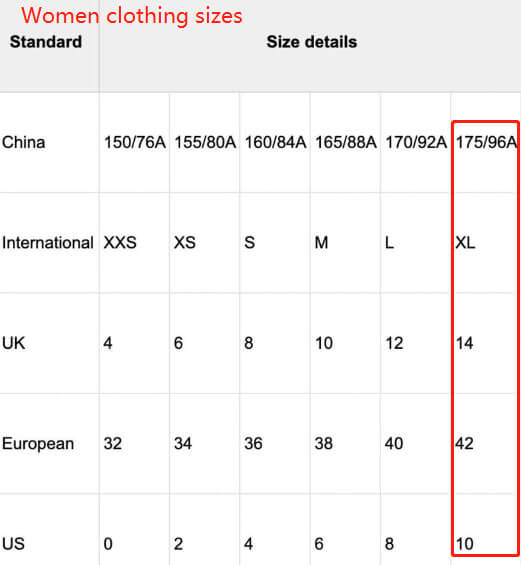Finding the perfect pair of shoes can be a challenge, especially when navigating different shoe sizing systems. If you’re a shoe enthusiast or a business owner looking to import footwear from Asia, understanding Asian shoe sizes and their conversion to U.S. sizes is essential. In this comprehensive guide, we’ll explore everything you need to know about Asian shoe sizes, including practical tips, real-world experiences, case studies, and a detailed size comparison table.
The Importance of Shoe Size Conversion
Shoe sizes vary significantly across different regions, and Asian footwear sizes can often be perplexing for those accustomed to U.S. sizes. To avoid discomfort or dissatisfaction with their purchases, it’s crucial for consumers to understand these differences. Understanding shoe size conversion helps prevent the hassle of returns and ensures better satisfaction with your footwear selection.
Statistically, the global footwear market is on track to reach $530 billion by 2027 (Statista). Therefore, understanding the nuances of shoe sizes across different regions can significantly enhance your shopping experience and boost business operations for retailers and e-commerce platforms.
Asian Shoe Sizes Explained

Asian shoe sizes often use a numerical system that varies by country. Major markets include China, Japan, and Korea. The sizing systems differ not only in the numbers they use but also in how they measure foot length and width.
Chinese Shoe Sizes
In China, shoe sizes are typically expressed in centimeters. For example, a size 38 shoe is designed for a foot length of approximately 24.5 cm. This straightforward system, based on actual foot measurements, makes it easier for consumers to find the correct size.

Japanese Shoe Sizes
Japan uses a similar metric sizing system, but they round up to the nearest whole number. A Japanese size 24 corresponds to a foot length of 24 cm. This can lead to some confusion for those familiar with U.S. sizing but is simple once you understand the conversion.
Korean Shoe Sizes
Korea also employs a centimeter-based sizing system. A Korean size 250 generally corresponds to a foot length of 25.0 cm. This similarity in measurement can lead to easier conversions between Asian and U.S. sizes once you grasp the basics.

Summary of Asian Shoe Sizes
| Country | Measurement System | Size Example | Foot Length (cm) |
|---|---|---|---|
| China | Centimeter | 38 | 24.5 |
| Japan | Centimeter (rounded) | 24 | 24.0 |
| Korea | Centimeter | 250 | 25.0 |
Comparing Asian Shoe Sizes to U.S. Sizes

Understanding the relation between Asian shoe sizes and U.S. sizes is vital. Here is a straightforward conversion table to help you navigate your options:
| U.S. Size | China Size | Japan Size | Korea Size |
|---|---|---|---|
| 5 | 35.5 | 22.0 | 225 |
| 6 | 36.5 | 23.0 | 230 |
| 7 | 37.5 | 24.0 | 240 |
| 8 | 38.5 | 25.0 | 250 |
| 9 | 39.5 | 26.0 | 260 |
| 10 | 40.5 | 27.0 | 270 |

Real-World Experiences with Asian Shoe Sizes
Many Americans have experienced the confusion of purchasing shoes online from Asian retailers. The disparity in sizing can lead to mishaps, such as receiving shoes that are too small or too large. Here are a few testimonials from actual customers:

Case Study 1: The Misguided Purchase
Jessica, a marketing professional from San Francisco, was excited to buy a stylish pair of sneakers from a popular Asian brand she discovered on social media. She typically wears a U.S. size 8.5, assuming she could simply convert to a size 39 in the Chinese sizing system. However, she ended up with a pair that was too snug. After realizing that Chinese sizes often run slightly smaller, she learned the importance of checking specific size guides provided by the brand.

Case Study 2: A Successful Order
On the other hand, Mark, a fashion enthusiast in New York, did his homework before ordering. He found a comprehensive size chart that detailed his size 10 in U.S. terms converted to a size 40.5 in China. His shoes arrived, and to his delight, the fit was perfect! Mark emphasized the importance of verifying size charts from the retailers and reading customer reviews to ensure accurate sizing.

Tips for Buying Footwear from Asia
Whether you’re shopping for personal use or sourcing products for a business, here are some practical tips to ensure a successful shoe purchase from Asian brands:
1. Always Consult Size Charts
Each manufacturer may have slight variations in their shoe size. Always consult their specific size chart for accurate conversions.
2. Look for Customer Reviews
Reading customer feedback can provide insights about sizing accuracy and general comfort. Look for comments on fit, comfort, and materials.
3. Understand Material and Design Differences
Keep in mind that styles and materials may vary significantly across different cultures. Asian footwear might have design features that differ from typically Western shoes.
4. Consider Foot Width
Asian shoe sizes often cater to different foot widths. If you have wide feet, make sure to check if the brand offers wide sizing options.
Product Highlights: Footwear from Asia
Asia is home to several well-known footwear brands. Here are some notable products that have gained popularity in the U.S:
1. K-Swiss
This American brand, popular in Asia, is known for its innovative athletic footwear. Their sizes can typically be converted directly from U.S. sizes, making them an excellent option for consumers.
2. Onitsuka Tiger
This brand offers stylish trainers that can be converted pretty straightforwardly between Asian and U.S. sizes. Their classic designs make them a popular choice among sneaker enthusiasts.
3. Li-Ning
Li-Ning is a Chinese sportswear company that has gained traction in the U.S. market. Their shoes often run true to size but be sure to check specific size charts before purchasing.
Pros and Cons of Asian Footwear Sizing
Pros
- Simple Measurement System: The centimeter-based system is easy to understand and minimizes errors.
- Variety of Options: Asian brands often offer a wide range of styles and sizes.
- Competitive Pricing: Many Asian footwear brands provide affordable options without sacrificing quality.
Cons
- Size Variability: Not all brands follow the same size chart, which can lead to confusion.
- Fit Issues: Different foot shapes and widths may not be adequately accommodated in certain brands.
- Shipping Challenges: Long shipping times and potential for return difficulties if the size is wrong.
Frequently Asked Questions (FAQs)
1. How do I convert my U.S. shoe size to Asian sizes?
To convert your U.S. size to Asian sizes, refer to specific size charts provided by the brand, as conversions may vary. Typically, you can find a reliable conversion chart online.
2. Is there a universal shoe size chart for Asian brands?
There is no single universal size chart, as different countries (China, Japan, Korea) have their own systems. Always check the brand’s specific chart.
3. Are Asian shoes generally narrower or wider?
Fit can vary by brand; however, some Asian shoe brands are known for being narrower than their U.S. counterparts. It’s essential to check width specifications if you have wide feet.
4. Can I return shoes that don’t fit?
Return policies vary by retailer. Always verify their return policy before purchasing, especially when buying from international sellers.
5. How can I ensure a good fit when buying online?
Measure your foot, consult sizing charts, read customer reviews, and check for brands that offer easy returns in case the fit isn’t right.
6. Do Asian shoe brands offer wide sizes?
Some brands do offer wide-fit options, but it’s not universally available across all Asian brands. Research the specific brand you’re interested in to confirm.
7. Are there any quality concerns with Asian footwear?
While many Asian brands are of high quality, it’s essential to do thorough research and read reviews to ensure you’re purchasing from a reputable brand.
8. What are some popular Asian footwear brands?
Some popular Asian brands include Onitsuka Tiger, Li-Ning, and Anta, all of which offer a variety of stylish and functional footwear options.
9. Can I find Asian footwear in U.S. stores?
Yes, many Asian brands have expanded into the U.S. market, and you can find them in physical stores as well as online retailers.
10. How do I know if I’m getting an authentic product?
Purchase from known retailers or directly from the brand’s official website to ensure you’re getting authentic products.
11. What should I do if my shoes don’t fit right?
If your shoes don’t fit properly, check the brand’s return policy and initiate a return or exchange as needed. Measuring your foot before the next purchase can help avoid future issues.
Conclusion
Understanding Asian shoe sizes in relation to U.S. sizes can significantly enhance your footwear purchasing experience, whether you’re a fashion-forward individual or a savvy business owner. By referring to conversion charts, reading customer feedback, and following the tips provided throughout this guide, you can navigate the complexities of international footwear with confidence. Happy shoe shopping!